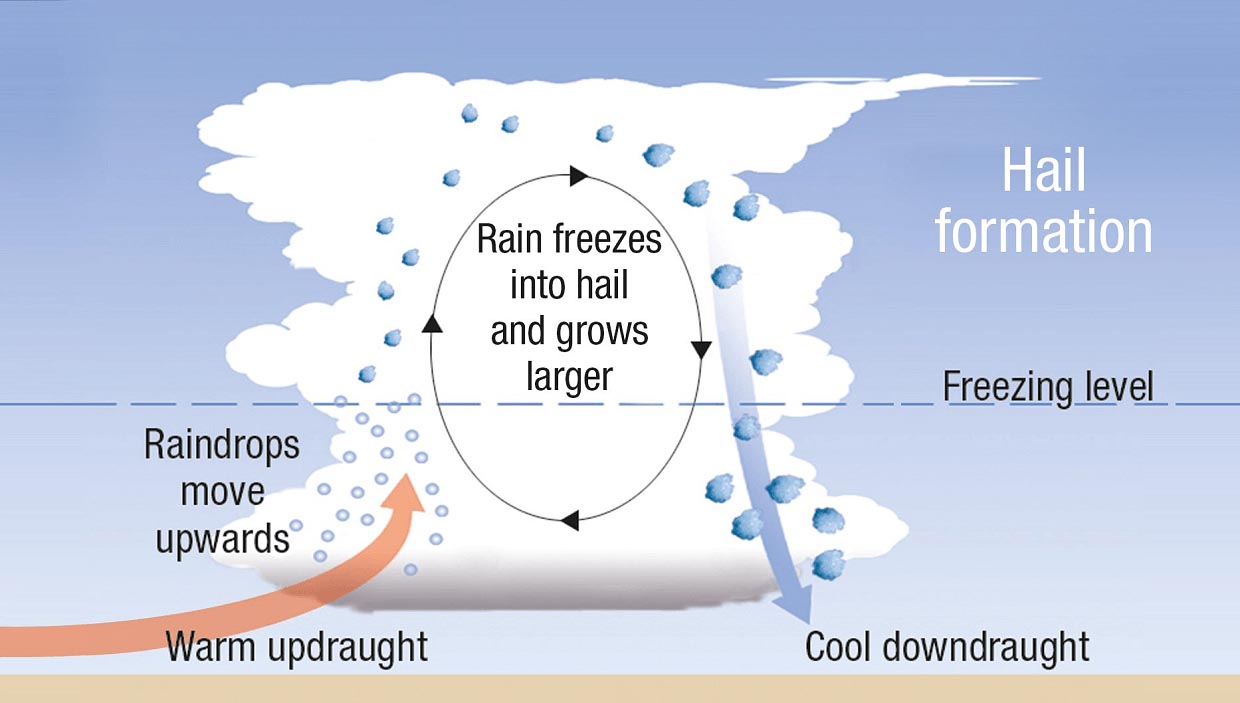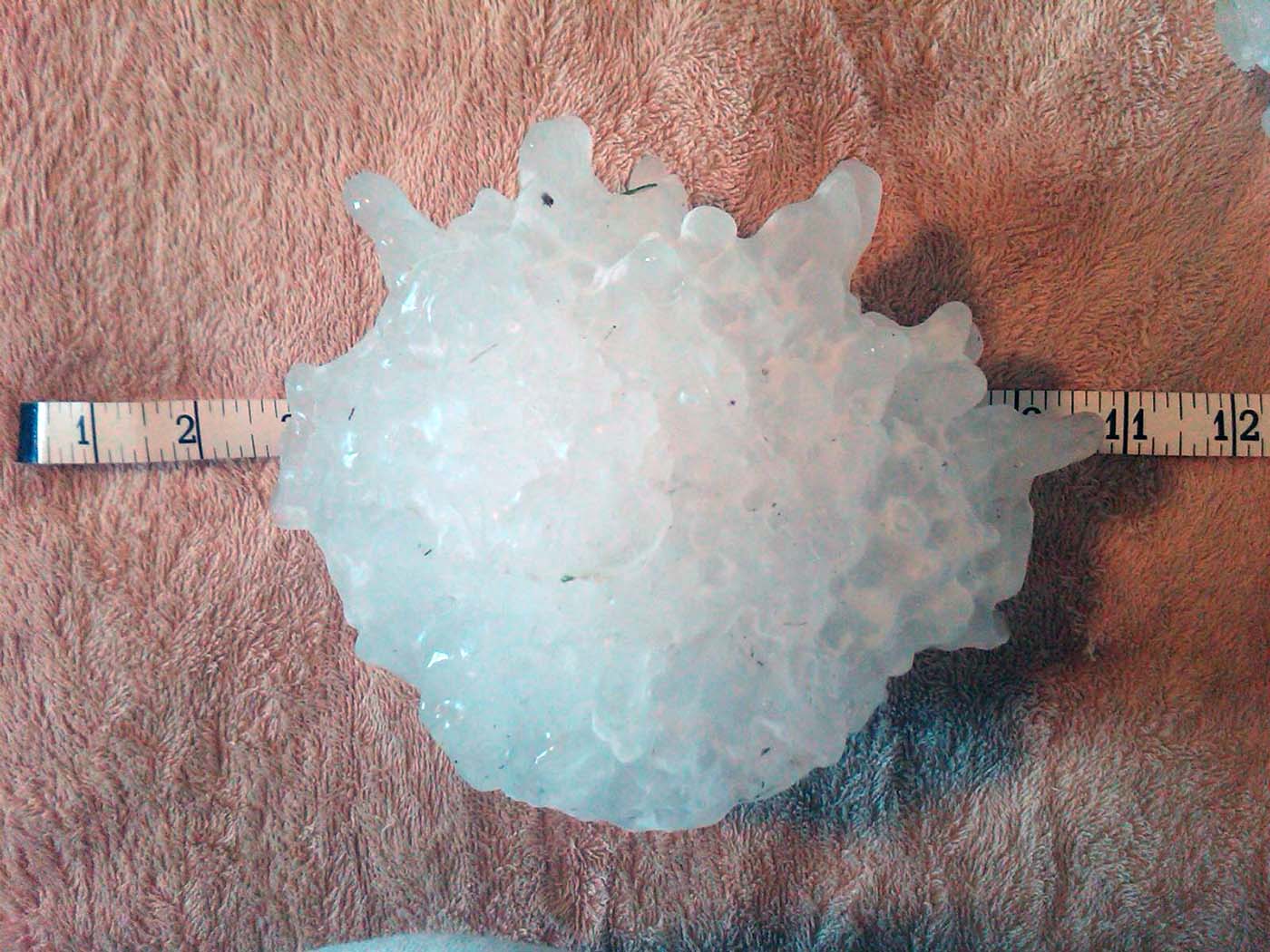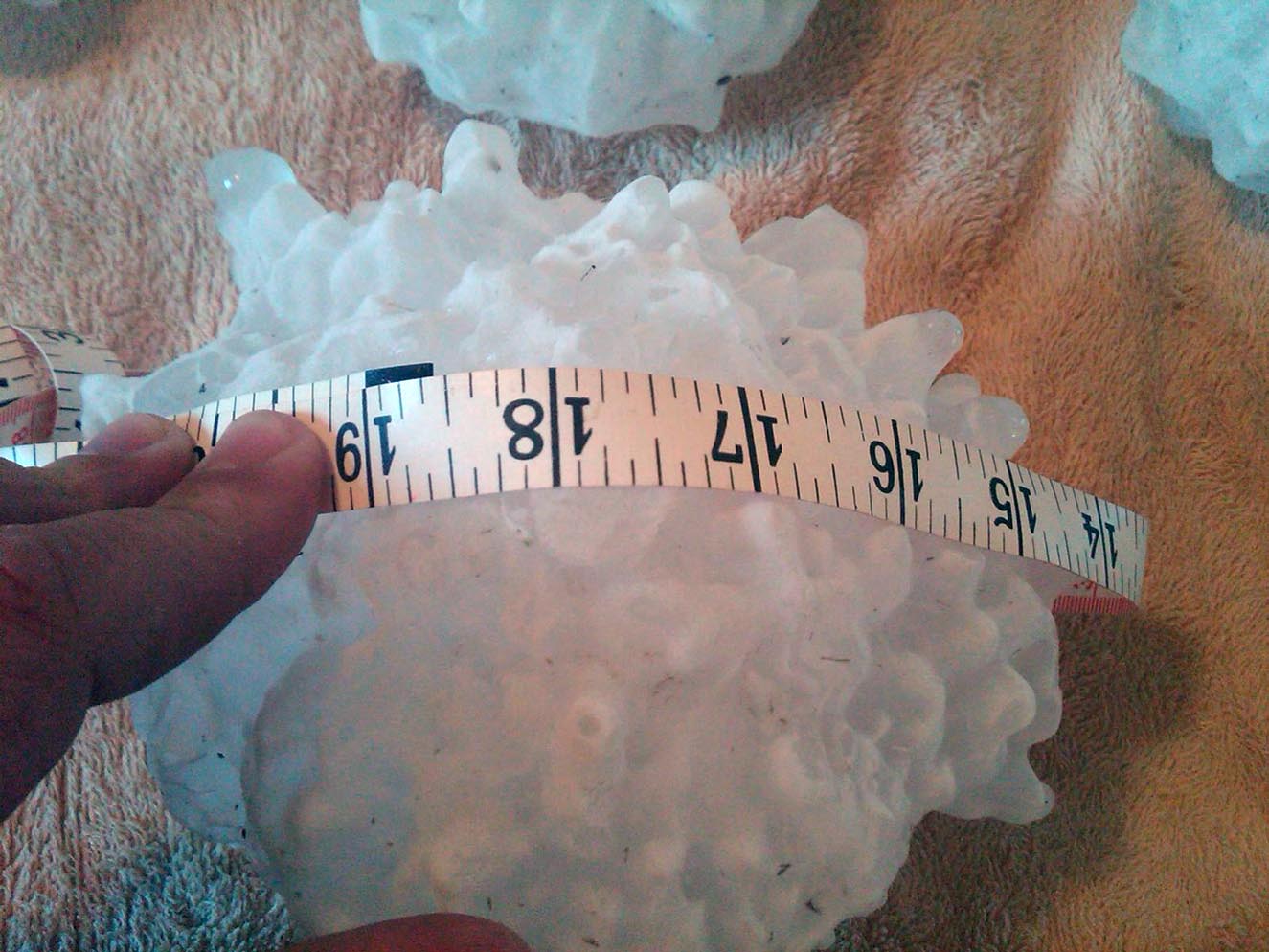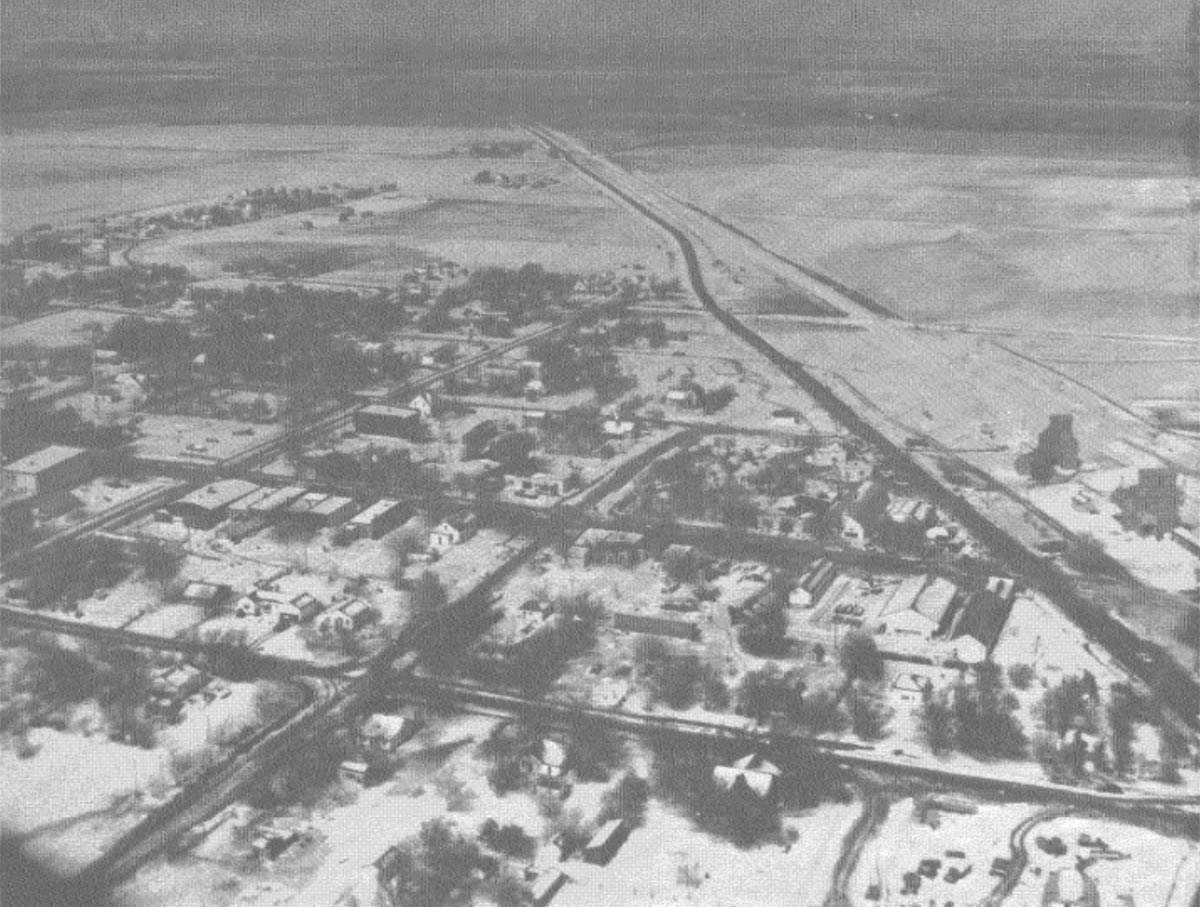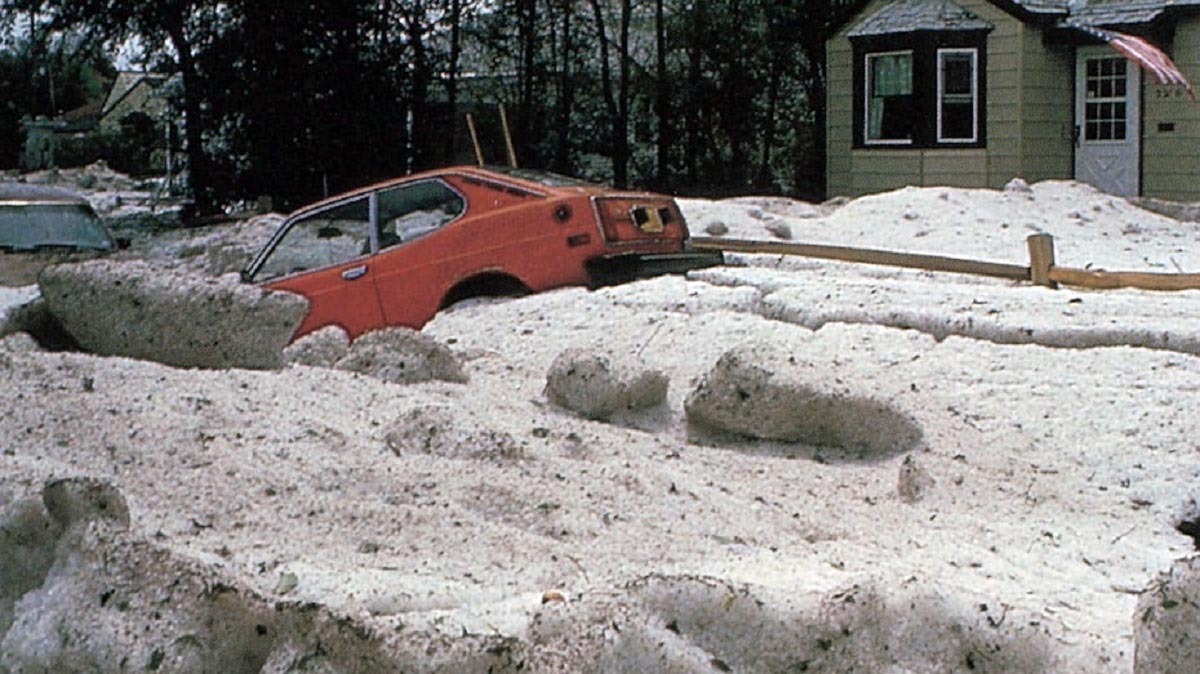Imagine a melon-sized chunk of ice falling out of the sky and punching a hole in your windshield. Your roof? Breaking bone? In this article, we take a look over the biggest, heaviest, and deadliest hail records on Earth.
Hail is one of the most significant hazards with severe thunderstorms – while it is usually small and relatively harmless, it may grow to tennis ball-sized or even larger. It may cause severe damage, injuries, and, in extreme cases, even death.
HAIL FORMATION – HOW HAILSTONES FORM?
Hail or hailstone forms as supercooled water droplets within a thunderstorm updraft begin freezing onto a condensation nucleus. The supercooled droplets have a temperature below freezing (0 °C or 32 °F), but still in a liquid state.
As they come into contact with the growing hailstone, they freeze onto it, making it grow larger. The growing hailstone is kept in the air by the storm’s updraft until it grows too big and heavy for the upward wind to keep it aloft.
The hailstone may make a single round within the storm’s updraft, but often, it makes several rounds within the updraft. Each round forms a new layer of ice around the chunk of ice, producing a concentric onion-like structure.
Some hailstones form and grow by many smaller hailstones sticking and freezing together into a large hailstone – such form is called an agglomerate. The largest hailstones sometimes even form long icy horns or spikes!
The most severe hailstorms and largest hail are usually associated with supercell thunderstorms. It takes very high to extreme instability, strong wind shear, and dry mid-levels for massive hail to form.
But just how big and heavy can hailstones grow? Below are some records for the largest, the heaviest, and the deadliest hailstorms worldwide.
LARGEST HAIL (HAILSTONE DIAMETER) EVER RECORDED
Villa Carlos Paz, Argentina – Feb 8th, 2018
On the 8th of February, 2018, gigantic chunks of ice were falling from the sky in Villa Carlos Paz, a resort city west of Córdoba, Argentina. A supercell thunderstorm bombarded the city center.
Researchers investigating the 2018 storm found that one of the hailstones had a diameter between 7.4 inches (18.8 cm) and 9.3 inches (23.6 cm) across. This diameter may approach or even exceed the official world record for the biggest hail – recorded in Vivian, South Dakota (see below).
The hailstones were so large that scientists suggested a new category to describe them — a gargantuan hail.
According to the official reports, this so-called ‘gargantuan’ hailstone that fell in Argentina may beat the world record, according to researchers. But these reports have not yet been officially confirmed.
According to the National Oceanic and Atmospheric Administration (NOAA), the world record for the largest hailstone is an 8-inch (20.3 cm) hailstone that fell near Vivian, South Dakota, in the United States in 2010.
Vivian, South Dakota – July 23rd, 2010
On July 23rd, 2010, 8 inches (20.3 cm) of hailstone was recorded in the severe hailstorm produced by the Vivian, South Dakota severe supercell. Mr. Lee Scott found the hailstone the size of a volleyball!
The hailstone had a circumference of 18.625 inches (47.3 cm) and a weight of 1.9375 pounds (0.88 kg). It produced an impact pit about 10 inches (25 cm) across the ground.
Tripoli, Libya – Oct 27th, 2020
The capital of Libya, Tripoli, was hit by a severe supercell storm on Oct 27th, 2020. The storm produced an exceptionally large, *giant* hail with an estimated diameter of 17-18 cm (6.5-7 inches). The event was associated with an upper-level trough moving across the Mediterranean late evening.
Local reports said the sudden storm severely damaged properties as many trees were knocked down and hailstones struck several vehicles. The Libyan Port and Shipping Authority confirmed that the port of Tripoli sustained damage, including fallen containers in the squares and port basin.
Here is another photo of a person holding these giant hailstones, easily between 16 and 18 cm (6-7 inches) in diameter. The rugged nature of this stone makes it very difficult to estimate its mass or equivalent spherical diameter.
There are other unconfirmed reports of similarly sized hail found. For example, Ponca City, Oklahoma, is reported to have been hit by up to 8 inches (20 cm) of hailstones on April 17th, 1935.
In Europe, the largest reported hailstone diameters in recent years were 15 cm on June 20th, 2016, in Sânandrei, western Romania, and 14.1 cm on August 6th, 2013, in Undingen in southwestern Germany. 14 cm hailstones were also reported in Stari Trg ob Kolpi, Slovenia, on June 11th, 2019.
In 2020, one giant hail event was also reported in Slovenia. The city of Domzale was hit by 10+ cm hailstones.
Azzano Decimo, Italy – July 24th, 2023 – New European hailstone record
In 2023, a new European hail record was set, with the record-breaking hailstone found in Azzano Decimo, Italy. Its diameter was an astonishing 19 cm! The hailstorm hit the town at 11 pm local time and destroyed hundreds of cars and roofs.

A week earlier, on 19 July 2023, severe hailstorms affected part of northeast Italy, producing giant hail. Hailstones with a more than 10 cm diameter were reported 24 times on this day: 2 times in Croatia and 22 times in Italy.
The largest hailstone fell in Carmignano di Brenta, with a diameter of 16 cm. Several other locations reported giant hailstones, as seen in the following photo.

Giant hail was also reported from Ribnik, Croatia, on this day. The estimated diameter was 13 cm.

LARGEST HAIL (HAILSTONE CIRCUMFERENCE) EVER RECORDED
Aurora, Nebraska – June 22nd, 2003
An 18.75-inch (47.6 cm) circumference hailstone was recorded on June 22nd, 2003, on a severe thunderstorm that hit Aurora, Nebraska, United States. The hailstone was 7.0 inches (17.8 cm) in diameter, but no weight was officially recorded as it partially broke off as it hit the roof of a house.
Notably, the hail that hit Hamilton County (including Aurora) produced impact pits up to 14.1 inches (36 cm) across the ground.
THE HEAVIEST HAILSTONE EVER RECORDED
Gopalganj district, Bangladesh – April 14th, 1986
The heaviest hailstone authenticated by official authorities fell during a severe hailstorm in the Gopalganj district of Bangladesh on April 14th, 1986. It weighed in at 2.25 pounds (1.0 kg).
The intense hailstorm killed 92 people.
In Europe, the record is held by a hefty 2.1 pound (0.97 kg) hailstone that fell in Strasbourg, France, on August 11, 1958 – unfortunately, no dimensions were recorded.
BIGGEST HAIL ACCUMULATION ON THE GROUND EVER RECORDED
Seldon, Kansas – June 3rd, 1959
A persistent, virtually stationary hailstorm hit Seldon, Kansas, on June 3, 1959. It produced a blanket of hail up to 18 inches (45 cm) thick over an area of (54 sq miles) 140 square kilometers.
DEADLIEST HAILSTORM
Moradabad and Beheri districts, India – April 30th, 1888
On April 30th, 1888, the deadliest hailstorm in modern history hit Moradabad and Beheri districts in Uttar Pradesh, India. It caused 246 fatalities, 1600 cattle and sheep, with hailstones as large as “goose eggs, oranges, and cricket balls”, according to the World Meteorological Organization.
The hailstones were reportedly as big as oranges and, in some places, accumulated to up to 2 feet in height.
VIDEO EXAMPLE OF SEVERE HAILSTORMS AROUND THE WORLD
- Huge Hail the Size of Baseballs – Cardston, Alberta – July 26th, 2012
- Incredible video of Oklahoma City Hail Storm – May 16th, 2010
- 8-inch hailstones in Vivian, South Dakota – July 23rd, 2010
- Mega Hail in SE Stephenville, Texas – Apr 26th, 2015
- Caught inside monster hailstorm, NW Texas – Apr 11th, 2016
Check some more interesting articles on the hail records:
- A historic long-lived supercell storm with giant 14 cm hailstones tracks for more than 1200 km across five European countries leaves severe wind and hail damage along its path – July 13th, 2023
- Exceptionally large 20+ cm (8 inches) hailstones hit the capital of Libya – Oct 27th, 2020
- Destructive hailstorm in central Slovenia – July 29th, 2020
- Europe’s hailstorms of 2023
- Vivian, South Dakota supercell chase report by storm chaser Mike Hollingshead – July 23rd, 2010
- Record-Setting Hail Event in Vivian, South Dakota – July 23rd, 2010
- Report on the Aurora, Nebraska hailstorm – June 22nd, 2003
- Understanding severe thunderstorms: criteria and impact
